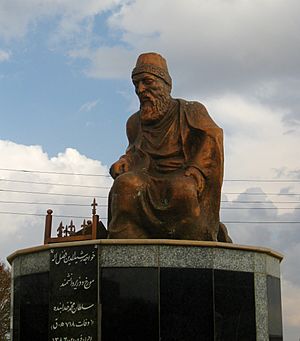Rashid-al-Din Hamadani facts for kids

Rashīd al-Dīn Ṭabīb (Persian: رشیدالدین طبیب), also known as Rashīd al-Dīn Faḍlullāh Hamadānī (رشیدالدین فضلالله همدانی, 1247–1318), was a very important person in Iran during the time of the Ilkhanate empire. He was a skilled statesman, a famous historian, and a doctor. He was born in Hamadan into a Persian Jewish family.
Rashid al-Din became a Muslim when he was about 30 years old. He then became a powerful vizier (a high-ranking advisor or minister) to the Ilkhanid ruler, Ghazan. He kept this important job until 1316.
A Great Historian and Author
Ghazan asked Rashid al-Din to write a special book called Jāmiʿ al-Tawārīkh. This book is now seen as the most important source of information about the Ilkhanate period and the Mongol Empire. It tells us a lot about history from that time.
Historian Morris Rossabi called Rashid al-Din "arguably the most distinguished figure in Persia during Mongolian rule." This means he was one of the most important people in Iran when the Mongols were in charge. He wrote many books and helped create an important learning center called the Rab'-e Rashidi in Tabriz.
The End of His Life
In 1318, Rashid al-Din faced serious accusations. After these events, he was executed.
Images for kids
-
Genghis Khan (center) at the coronation of his son Ögedei, Rashid al-Din, early 14th century
-
Hulagu Khan with his Eastern Christian wife, Doquz Khatun. Hulagu conquered Muslim Syria, in collaboration with Christian forces from Cilician Armenia, Georgia, and Antioch. From Rashid al-Din's work.
See also
 In Spanish: Rashid-al-Din Hamadani para niños
In Spanish: Rashid-al-Din Hamadani para niños







